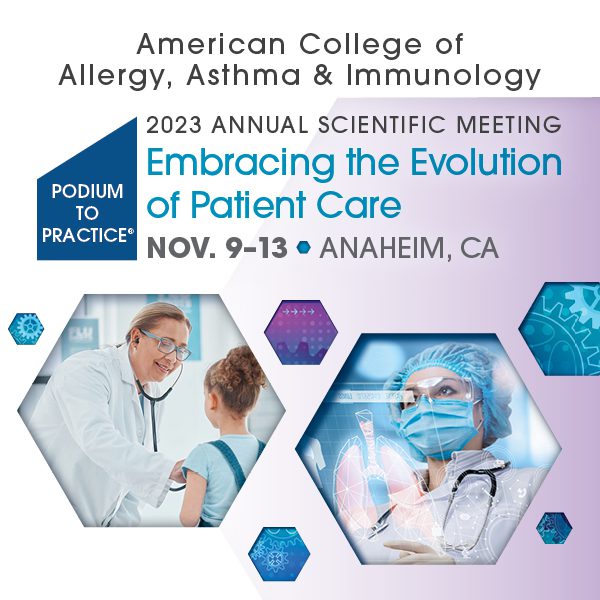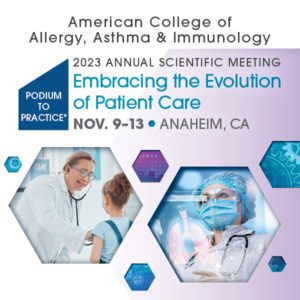November 8, 2023
Food allergic patients have a variety of theories on how their allergy started
ANAHEIM, Calif. (Nov. 9, 2023) – It’s estimated that 33 million Americans have food allergies, including 5.6 million children under age 18. The cause of food allergies is unknown, although researchers and food allergy experts have ruled out some common theories of how they develop. A new study being presented at this year’s American College of Allergy, Asthma and Immunology (ACAAI) Annual Scientific Meeting in Anaheim, Calif. shows that, among people who suffer from food allergies, common themes arose regarding when their food allergy developed and coinciding with certain events including, eating too much of the allergenic food; genetics and family history; antibiotic use; and eating too little of the allergenic food.
“Through an NIH-supported Food Allergy Prevalence Questionnaire, we collected nationally representative data for 38,408 children and 40,443 adults,” said Christopher Warren, PhD, ACAAI member and co-author of the study. “We know there are many theories about how food allergies develop, and there are many causal factors that likely contribute to the present food allergy epidemic. We have never had the opportunity to directly ask a large, national sample of food allergy patients and pediatric caregivers about the factors they noticed as related to their own food allergy development. When we directly engaged these food allergy patients/caregivers, nearly one in five reported that eating too much of an allergenic food coincided with their food allergy development, while 12% of adults reported that antibiotic use did. Notably, nearly one in four caregivers of children under the age of 17 reported that their child’s food allergy development coincided with a viral infection.”
Survey respondents were categorized as having self-/parent-proxy reported food allergy, convincing food allergy according to reported food-allergic reaction symptoms consistent with an IgE-mediated response, as well as reported cases of convincing food allergy that were physician diagnosed.
“We now know that eating certain allergenic foods, like peanuts, if eaten starting in infancy, can prevent peanut allergy,” says Ruchi Gupta, MD, ACAAI member and senior author of the study. “Allergists and other health care professionals can help get the word out to parents of infants and others that it’s preventative to introduce certain allergenic foods early in life. For new-onset adult allergies, understanding potential triggers that may be involved with the development of an allergy is critical. Factors like infections, changes in the environment, and hormonal changes may be factors contributing to developing an allergy later in life and need more exploration.”
Abstract Title: Understanding perceived determinants of food allergy in a US population-based sample of children and adults
Presenter: Rachelle Liu, BA
For more information about severe food allergies and anaphylaxis, or to find an allergist in your area, visit AllergyandAsthmaRelief.org. The ACAAI Annual Scientific Meeting is Nov. 9-13. For more news and research from the ACAAI Scientific Meeting, go to our newsroom and follow the conversation on X/Twitter #ACAAI23.
About ACAAI
The American College of Allergy, Asthma & Immunology (ACAAI) is a professional medical organization of more than 6,000 allergists-immunologists and allied health professionals, headquartered in Arlington Heights, Ill. Founded in 1942, the College fosters a culture of collaboration and congeniality in which its members work together and with others toward the common goals of patient care, education, advocacy, and research. ACAAI allergists are board-certified physicians trained to diagnose allergies and asthma, administer immunotherapy, and provide patients with the best treatment outcomes. For more information and to find relief, visit AllergyandAsthmaRelief.org. Join us on Facebook, Pinterest, Instagram and Twitter/X.
P187
UNDERSTANDING PERCEIVED DETERMINANTS OF FOOD ALLERGY IN A US POPULATION-BASED SAMPLE OF CHILDREN AND ADULTS
R. Liu*, C. Warren, R. Gupta, Chicago, IL
Introduction: Food allergy (FA) is a major public health problem, and little work to date has aimed to understand the perceived etiology of FA. This knowledge would provide context for current health behavior and potentially identify areas for targeted interventions, including patient and caregiver education.
Methods: A cross-sectional food allergy survey was administered to patients and caregivers via phone and web via a NIH-supported Food Allergy Prevalence Questionnaire in 2015-2016, which collected nationally-representative data for 38,408 children and 40,443 adults. Respondents were categorized as having self-/parent-proxy reported FA, convincing FA according to reported food-allergic reaction symptoms consistent with an IgE-mediated response, as well as reported cases of convincing FA that are physician diagnosed.
Results: In adults and children with physician confirmed FA, the measures most perceived to be associated with development of FA were eating too much of the allergenic food [18.6% (95%CI:17.0-20.3)], genetics and family history [16.3% (95%CI:14.8-17.9)], antibiotic use [12.5% (95%CI:11.3-13.8)], and eating too little of the allergenic food [10.2% (95%CI:8.8-11.8)]. In populations 0-10 and 11-17 years old, respondents associated developing FA with a viral infection [23.8% (95%CI:21.1-26.7), 25.6% (95%CI:22.0-29.5)].
Conclusion: The findings highlight important factors such as diet, genetics, family history, and infection that are believed by parents and adult patients to be associated with FA development. Understanding these perceptions can inform targeted interventions and patient education efforts to improve FA management and prevention.

